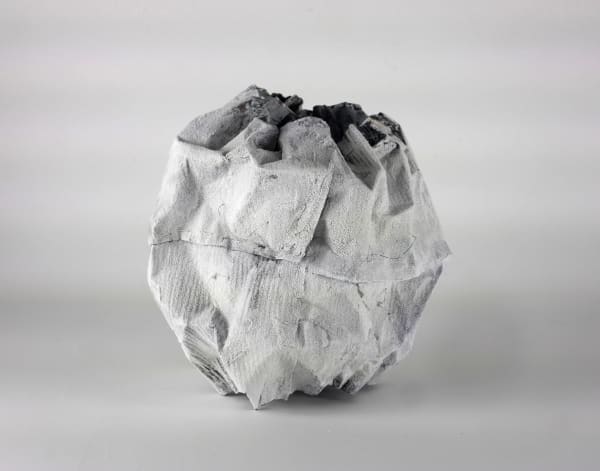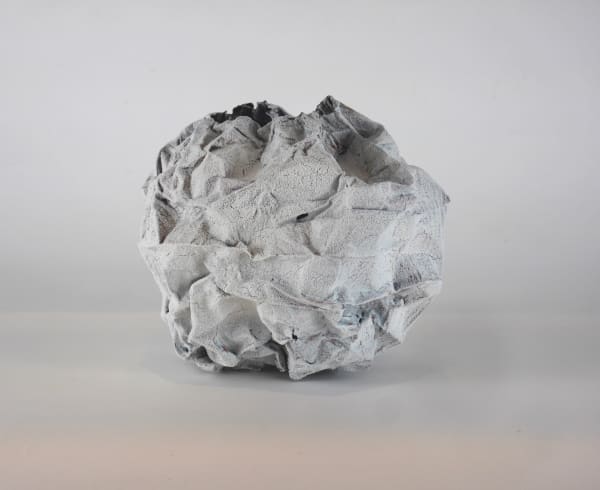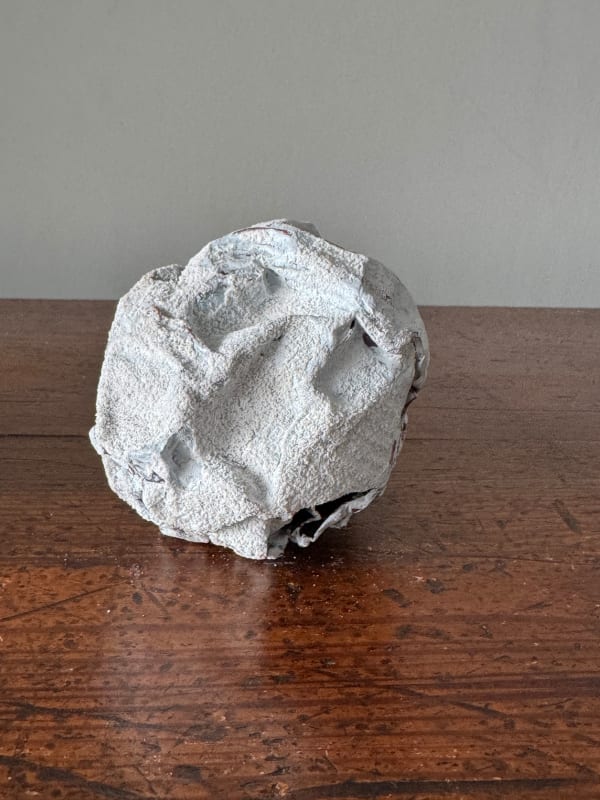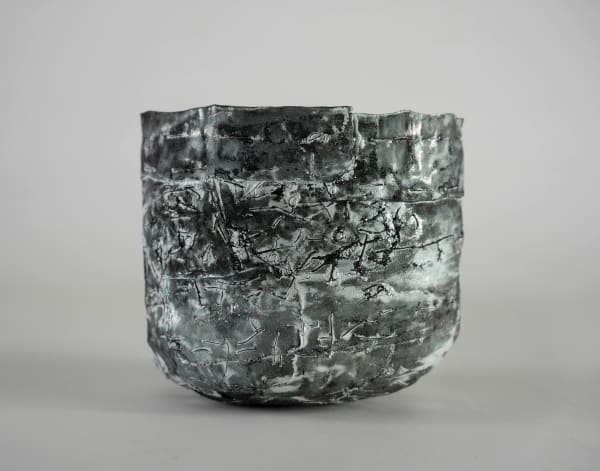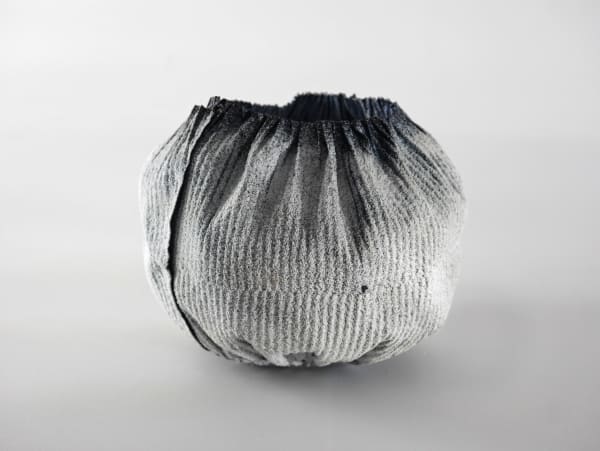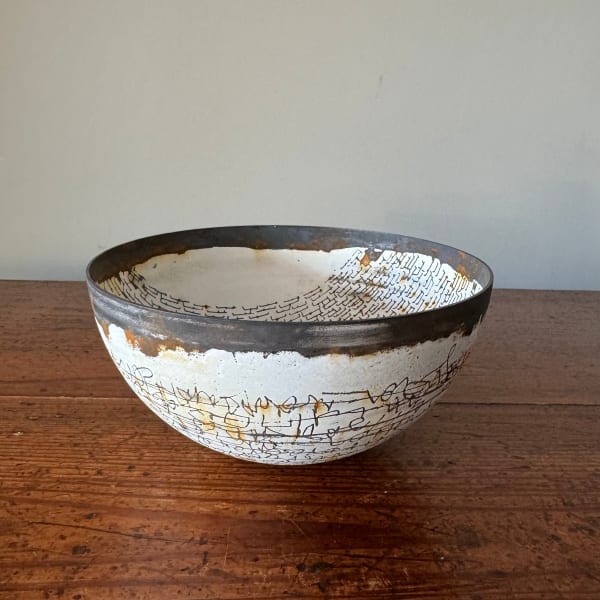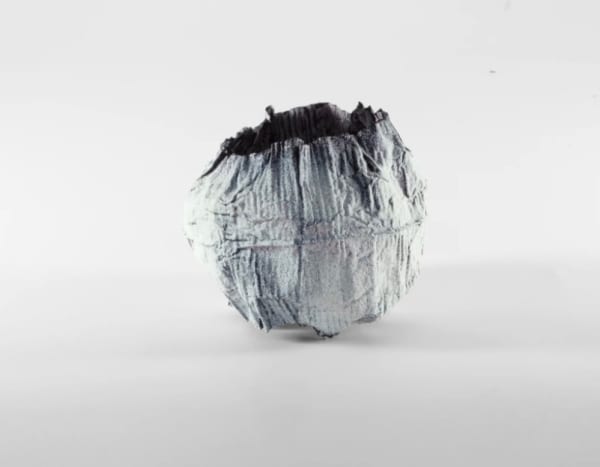In the wake of her first museum acquisition in the UK, Cavaliero Finn talks to artist Helen Carnac about her work

Helen Carnac in her studio - image by Alun Callendar
-
When we first saw Helen Carnac’s work at the RWA in Bristol last summer we were intrigued. It wasn’t the form that pulled us in initially but the material, we couldn’t place it. Its texture and delicacy really captured our attention and when we saw that it was made of copper and vitreous enamel we were totally flummoxed. Fuelled by curiosity, we arranged a visit to Helen’s studio in West Somerset to find out more.
We subsequently debuted two bodies of Helen’s work at our Winter show at Cromwell Place at the tail end of last year and were delighted with the reaction the work received. We were especially pleased when the V&A acquired ‘Overlap III’ for their permanent collection after seeing the piece at the exhibition. Speaking about the work Rebecca Knott, Curator of Metalwork at the V&A said: "We are so thrilled to have been able to acquire Overlap III for the V&A collection. The piece is an excellent example of Helen's innovative approach to working with enamel."
Helen has several works in museums and public collections in the USA and Canada and is particularly excited by this acquisition as its her first museum in the UK. Read on to find out more about this piece and Helen's work in general in our latest in conversation interview. -
Cavaliero Finn: The V&A recently acquired Overlap III from our Winter show at Cromwell Place. Can you tell us a bit about this piece and your most recent work?
Helen Carnac: "Overlap III is part of a new series of vessels called Ammil, an old English word which means 'a coat of glittering ice that covers grass, leaf and stone when freeze fast follows thaw'. It's very much inspired by the changing landscape.
"The vessel was made by folding up, unfolding and re-folding very thin shim copper into a form before sewing it together with wire. I then coated it with multiple layers of both liquid and powdered vitreous enamels and fired it at temperature multiple times.
"The final layer was fired at a lower temperature so that the enamel fused to the previous layer but retained its powdery form. This is known as a sugar coat. I work with both industrial process vitreous enamel (a combination of ground glass and porcelain) and powdered ground vitreous enamels, both types are fused to metal at high temperatures. Industrial enamel is the material that the London tube signage or your bath might be made from. I use sgraffito techniques to explore surfaces and mark-make, encouraging the surfaces of my work to rust and oxidise."
CF: You have had work in several notable public and private collections in the USA and Canada for a number of years, what does it mean to you to have your first piece in a public collection in the UK?
HC: "It's an absolute honour: having a work in a collection in my home country was something I really wanted to achieve and that it's at the V&A is incredible to me."
-

Helen Carnac
Small Vessel 2, 2023CF: We love the way you make your some of your copper metal sculptures look paper-like. How did this way of working come about?
HC: "It came about through having an experimental approach to materials and making I think. I want to know what materials can do, I'm interested in their attributes - how soft or hard, light or heavy, ductile or malleable something is. I spend a great deal of time manipulating material, often it's either paper or metal and I go back and forward between the two trying to find some sort of quality and texture. I want my surfaces to be papery, light and to convey a fragility. I do get feedback from viewers of my work about how they don't really know what it's made from, I feel this is the response I'd like to achieve, I don't necessarily want the material to be obvious."
-

Helen Carnac
Counting Vessel II, 2022CF: Could you tell us a little bit more about your steel and enamel vessels?
HC: "In the first series of these vessels which I made in 2007, I wanted to explore drawing in enamel on a three-dimensional form, as it is so different to drawing on a two-dimensional surface. When the enamel is applied it is wet and left to dry to a plaster surface which can then be drawn into before it is fired in an enamel kiln and then finely abraded back to develop a matt surface and to reveal the steel substrate which I encourage to oxidise and rust. The original pieces were called Each Other - the enamel vessels sitting on a drawn and printed surface which were made in a back and forward process, working between the two and three-dimensional surfaces."
-
CF: What first attracted you to working with metal and enamel?
HC: "I have always been aware of a personal (post) industrial context surrounding me and my work. I was brought up in rural South Wales, near the mining, farming and steel-making industries. Some of my family had been miners in the Forest of Dean, one grandfather was an engineer at the Royal Arsenal, London and the other worked at the Sun Engraving Company. My uncles followed him into the printing industry on Fleet Street and my sister is a metal industry expert. Consequently, materials and production are close to me.
"Watching the demise of many industries in my childhood and teenage years, I became fascinated by a post-industrial landscape and have spent much time walking in these landscapes, becoming increasingly interested in the micro examination of surface, patina, and decay. The traces of time and of presence have informed my drawn, abraded, and sgraffitoed vitreous enamel panels. The visual research for these having been made on long walking field trips, where I have made scores of photographs and drawings as well as written notes.
"My interest and work with vitreous enamel began when I was studying at The Cass Art School, London in the early 1990s. I was fascinated by the vitreous enamel London Underground tube signs (manufactured around 1908) at Aldgate East station, where my college was located. I would always walk by and touch the surface of the signs and look at the edges where the layers of enamel were sometimes chipped. A combination of coldness to touch and glassiness led me to understand that this material was glass on a steel substrate and this opened up a curiosity about the material and its production for me.
"Once I began to work with the material I was drawn into it very quickly. Learning traditional techniques at first, I was excited about the potential for experimentation with the material and process and this led to me adopting an approach which I still follow today. Each piece I make is an ongoing experiment and informs the next piece I make."
-
View all available work by Helen Carnac
-
 Helen Carnac, Balled Vessel I, 2024£ 1,980.00
Helen Carnac, Balled Vessel I, 2024£ 1,980.00 -
 Helen Carnac, Crushed Vessel 1, 2025£ 3,960.00
Helen Carnac, Crushed Vessel 1, 2025£ 3,960.00 -
 Helen Carnac, Fold Vessel 1, 2025£ 3,550.00
Helen Carnac, Fold Vessel 1, 2025£ 3,550.00 -
 Helen Carnac, Like Paper I, 2025£ 880.00
Helen Carnac, Like Paper I, 2025£ 880.00
-
 Helen Carnac, Like Paper II, 2025£ 880.00
Helen Carnac, Like Paper II, 2025£ 880.00 -
 Helen Carnac, Stitched Red Marl, 2025£ 4,650.00
Helen Carnac, Stitched Red Marl, 2025£ 4,650.00 -
 Helen Carnac, Outcrop 1, 2024£ 2,650.00
Helen Carnac, Outcrop 1, 2024£ 2,650.00 -
 Helen Carnac, Small Vessel I, 2023£ 1,750.00
Helen Carnac, Small Vessel I, 2023£ 1,750.00
-
-
CF: Tell us more about your training?
HC: "I first studied metalwork at school and have a (rare) O Level in Jewellery Design. After an art foundation in Newport, South Wales, I completed an HND in Design Crafts, Blacksmithing, Silversmithing and Jewellery at Plymouth College of Art and Design in 1990. Followed by a four-year BA in Silversmithing, Jewellery and Allied Craft at The Cass, London Guildhall University. During this time I also studied on an Erasmus programme in Germany and worked for a year for both Tom Dixon and Jocelyn Burton. Late in the 1990s I started teaching, which I did alongside making my work for twenty years, I think you learn incredible amounts as you teach and so consider it part of my training."
CF: You recently moved out of London to rural Somerset after living and working in the city for over 20 years, how has this move influenced your work?
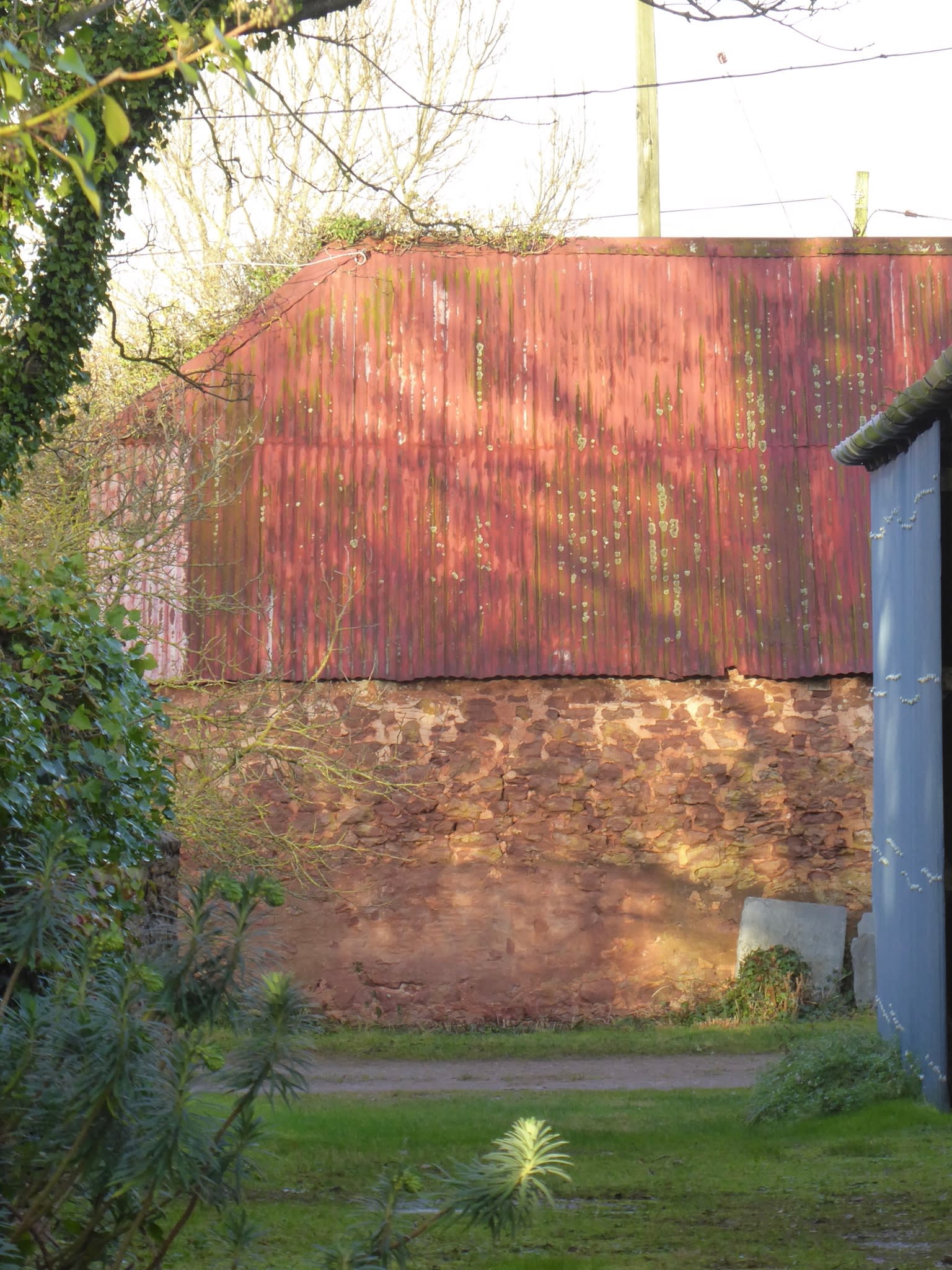
View of the rural surroundings that are a daily inspiration to Helen
HC: "I moved from London to rural West Somerset at the end of 2020, the rural outdoor environment has become vital to the development of my work. Having explored the industrial landscape of the Thames where my previous studio was located for many years, the transition to a new environment has been invigorating. I now live in an iron-rich landscape, near the old Mineral Line, which is where iron ore was taken from Exmoor to the coast, at Watchet, and on by boat to the steelworks in South Wales. In my daily walks, I encounter corrugated sheds and derelict farm buildings. I document the nearby ploughed fields watching them change as the light and weather shifts. I feel incredibly connected to the material of the place and am finding ways to incorporate this into the work I am making.
"The new Ammil series is directly related to my response to this new and changing landscape. I wanted it to have a sense of fragility - its surface suggesting that it may shed a layer or thaw out, whilst, in reality, it is very robust, the sewn and fired surface giving it strength." -
CF: You often work collaboratively, thinking about your most recent collaboration with Alice Kettle and Carinna Parraman, what does this bring to your practice?
HC: "I really find working with others incredibly invigorating, I like to talk about ideas, hear others’ thoughts and share ideas, and swap materials and ways of handling them. Carinna, Alice and I had all moved to different parts of rural Somerset within a few years of each other and we have been sharing ideas about locality, local materials, wildlife, plant life, skies, clouds, rain and how to make these ideas into a work. Very joyful and ongoing hopefully."
-
CF: Talking of working with other artists, this doesn't just include visual artists does it? You've also worked with choreographer and dancer Laila Diallo a number of times, how has this influenced your practice?
HC: "I was incredibly lucky to be invited to be in a six-week, two-person, collaborative residency by Siobhan Davies Dance in 2012. The company asked Laila and I to work together as they felt they could see affinities between our practices and they wanted to document the processes of two artists working together as part of an archive that is held at Coventry University. I have worked with Laila since then on several occasions, once being commissioned to make a work (Edge and Shore) which we showed and performed at various galleries including the Arnolfini in Bristol and the Whitechapel in London. We initially spent a great deal of time finding ways to talk about and make work together and set up a very good working relationship, which I believe has helped us to work long-term as we built an enormous level of trust and respect for each other and our respective work. The initial residency really made me consider my body more and what I’m doing with it as I work (I usually stand when I’m working) and I move things around (materials and objects) as a way of working ideas out. Now, even years later, I often think through ideas that we came up with together and consciously think about the actions I make in order to make a piece of work - the Ammil works definitely come out of this thinking process, where I go through a series of actions to make a piece, ripping, folding, squashing and unfolding for example."
-
CF: Where do you think your work will go next?
HC: "I’m currently experimenting with stainless steel meshes - they are so fine that they are almost like fabric. I want to make something light and fragile again, but I’m at the stage where I don’t know how it may develop and have to work with the unknown for some time yet.
"I’m also spending a great deal of time planting and growing things and have been exploring ways to set up a small residency here in the future. My partner artist David Gates and I are very much into making a space that supports nature and we’d like to be able to share what we are doing with others, in ways yet unknown. In the last few years we’ve planted 700 trees, two meadows and are managing the outside spaces as a wildlife-friendly environment, we are also trying to do up a slightly run-down 17th-century farmhouse. These days I see all this as one big piece of work."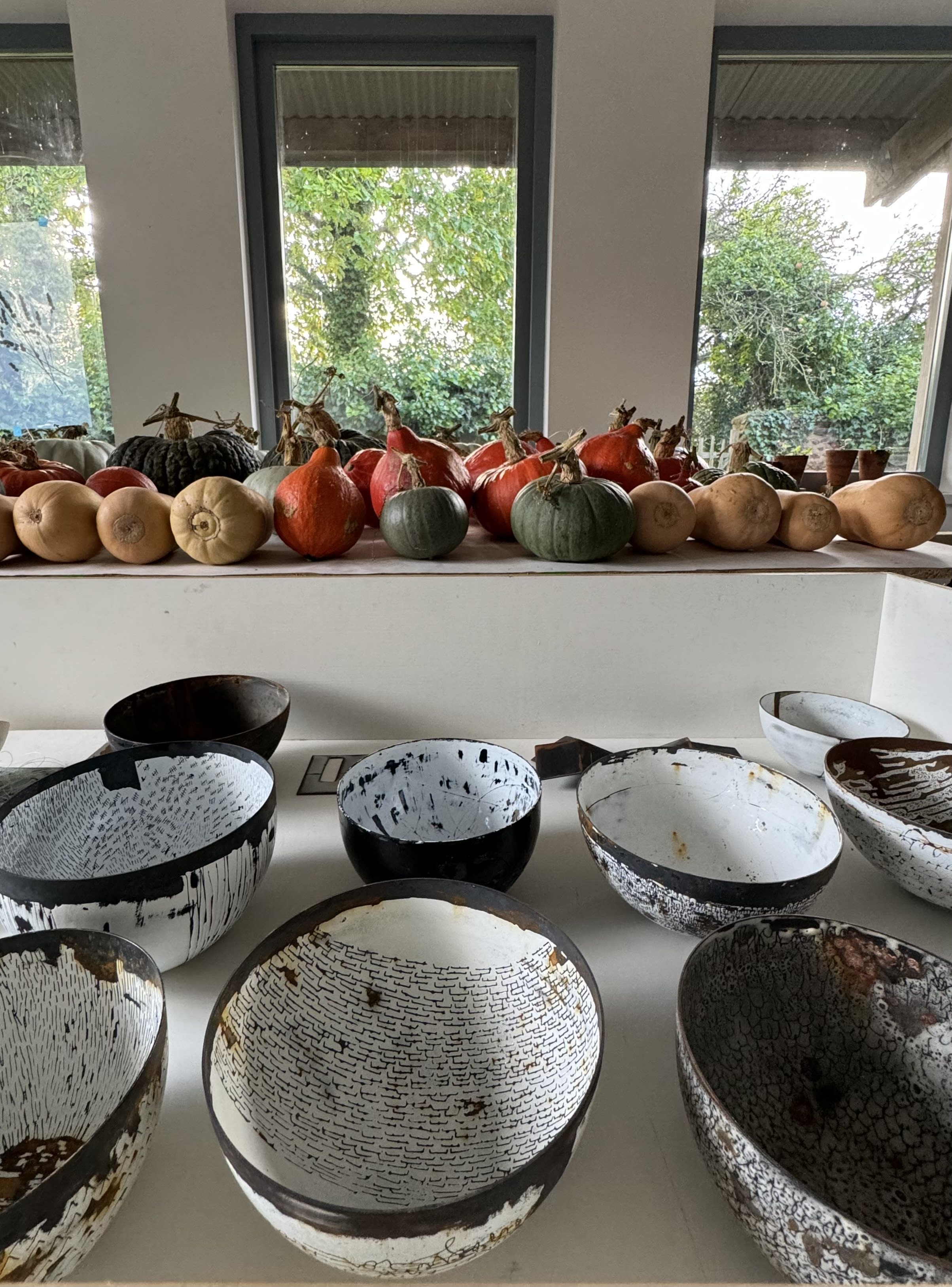
Fruits of her labour - Helen's steel and enamel, hand drawn sgraffito vessels sit happy alongside the hand grown produce from her garden which ripens in the studio windows.
-
Listen to Helen speak about her work at our Winter Show at Cromwell Place
Artist Helen Carnac discusses the significance of location, landscape, weather, geography, and land structures in her practice at Cavaliero Finn's latest show Winter - the weakening eye of day




